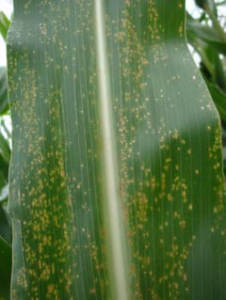- Holcus leaf spot is a bacterial pathogen that typically enters corn plants through wounds caused by thunderstorms, high winds, or hail.
- Symptoms of this disease can be confused with injury from a herbicide or as a fungal disease, so it is important to carefully identify Holcus leaf spot.
- Generally, yield potential is not impacted by Holcus leaf spot.
Background
Holcus leaf spot is a bacterial disease caused by the bacterium Pseudomonas syringae pv. syringae. This pathogen overwinters in a variety of hosts, including both monocot and dicot species. Incidence of the disease typically occurs earlier in the growing season after heavy winds or thunderstorms.1 Hail and damage from blowing soil can create plant wounds that enable disease transmission.2 Plant injury is not required for disease transmission, as Holcus leaf spot can also enter natural plant openings such as leaf stomata (transpiration openings).3 Extended wet weather and warm temperatures can also increase the appearance of symptoms, but new leaves typically are not affected.(1,2)
Identification
Symptoms of Holcus leaf spot begin as dark green lesions with water-soaked margins near the tips of lower corn leaves and progress into round or oval shaped light brown to white spots around 1/8- to 1/4-inch in diameter. Reddish brown margins can form around the lesions surrounded by yellow halos (Figure 1).1 Lesions can expand and merge into streaks of necrotic tissue, eventually drying out and having a papery texture.(2)

Figure 1. Holcus leaf spot lesion with a distinctive halo.
Holcus leaf spot can be confused with paraquat drift damage because both the corn crop and several surrounding weed host species may express similar symptoms.3 Holcus leaf spot may also be mistaken for a fungal disease like eyespot, which also has round spots with a brown border and yellow halo (Figure 2) .2 However, eyespot lesions are considerably smaller and more numerous than those of Holcus leaf spot as shown when comparing Figures 1 and 2. Misdiagnosing a bacterial disease as a fungal disease can lead to unnecessary fungicide application.

Figure 2. Eyespot lesions on a corn leaf, which are smaller and more numerous than Holcus leaf spot lesions.
Impact on Corn Crop
Holcus leaf spot is generally superficial and does not negatively impact corn yield potential. Management of weedy hosts and tillage may help reduce overwintering of the pathogen in crop residue, but only when it is practical to do so.3 There are no in-season management options for Holcus leaf spot. It is important to carefully distinguish between Holcus leaf spot, which does not require treatment, and a possible fungal disease, which may benefit from a fungicide application.
